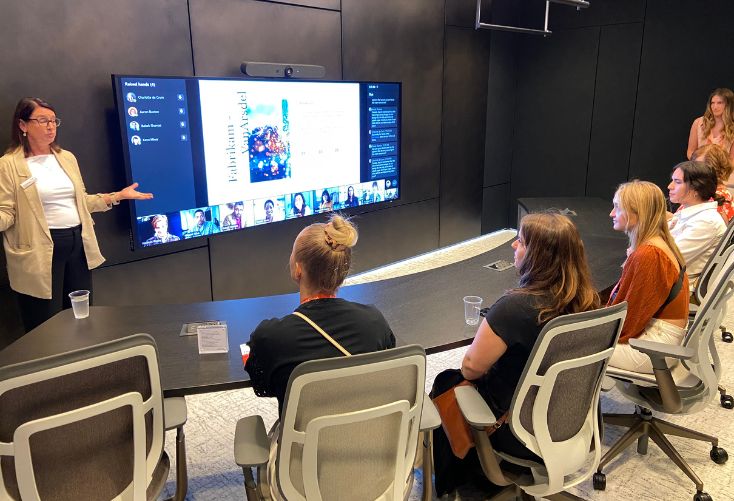- This week Chicago welcomed the office furniture industry’s largest event, NeoCon.
- A trend at the forefront of NeoCon was driven by younger generations of workers, whose devices have always been wirelessly connected, creating demand for areas dedicated as waiting or lounge areas to increasingly become primary work stations.
- Although the prediction that many private workstations will be phased out with the new hybrid work arrangements, the trend in utilizing conference rooms has grown.
This week Chicago welcomed the office furniture industry’s largest event, NeoCon. Every June the historic merchandise mart opens its doors to designers, architects, manufactures, workplace consumers and influencers. This year, Allwork.Space attended NeoCon in order to understand what the future of the office will look like.
Months, perhaps years of preparation had gone into the new products that were launched at the show. Many products were ready for market as soon as the curtain lifted and the doors opened, while others were merely teases of concepts that may become reality in some years down the road. NeoCon serves as both a showcase of today’s trends and a peek at what may be on the horizon.
Furniture manufacturers large and small have set out to try to answer really big questions: Who’s coming back to the office? Why? What are they expecting when they get there?
 This has led to the biggest trend of NeoCon: The hotelification of the office.
This has led to the biggest trend of NeoCon: The hotelification of the office.
Inspired by expanding open plans, adoption of coworking, progressive work arrangement and task-based designing, the workplaces of NeoCon exhibited variety in the settings.
At the show, the modern version of a cubicle was packed with new features for an ever-changed workforce. These small areas were decidedly private, both visually and acoustically, but also with a variable sense of “do not disturb” built into the orientation.
 In the context of choice and a variety of different levels of interaction throughout the day, the office will always need a large number of individual heads-down work areas. The spaces featured are simple, clean and highly adjustable, as well as ergonomic.
In the context of choice and a variety of different levels of interaction throughout the day, the office will always need a large number of individual heads-down work areas. The spaces featured are simple, clean and highly adjustable, as well as ergonomic.
The most creative adjustability components were featured at Steelcase and Haworth, with workstations that could quickly be converted by the user to accommodate video calls that presumably will be a part of daily life from now on. Acoustic panels could be repositioned from close to distant in order for better sound masking.
Even before the pandemic, lounge and casual seating were both starting to have a huge presence in the modern office. This was partly because our devices have become untethered and bosses have become more allowing of workers to untether as well.
Arguably driven by younger generations of workers whose devices have always been wirelessly connected, areas dedicated as waiting or lounge areas have increasingly become primary work stations. This trend was front and center at NeoCon, with brands like Animate and others providing new solutions to add power to these casual couches and comfy chairs.
 These open areas also provide two valuable additions to the office; the first being that meetings don’t have to happen in meeting rooms, nor do they have to be formal. Brands like MillerKnoll and Watson have showcased creative ways to still incorporate large shared screens into the lounge settings.
These open areas also provide two valuable additions to the office; the first being that meetings don’t have to happen in meeting rooms, nor do they have to be formal. Brands like MillerKnoll and Watson have showcased creative ways to still incorporate large shared screens into the lounge settings.
These spaces naturally allow people to be as close or as far away from others as they are comfortable, usually well beyond the 6-feet rule still present in our collective behavior.
When a private meeting space was required, for privacy or politeness, even those meeting rooms saw an evolved layout. At first glance, it’s easy to see that meeting rooms have gotten larger, which can be accomplished with smaller meeting spaces transitioning into open areas.
Although the prediction that many private workstations will be phased out with the new hybrid work arrangements, the trend in utilizing conference rooms has grown. This may be indicative that people still want to be at a safe distance from one another, but still able to physically interact. The rooms showcased at the conference included a more interactive section with whiteboards and creative supplies to brainstorm on problems during a meeting.
One of the most creative designs was at Steelcase, which was able to use an existing conference room. The large monitor that would typically be at the head of a table was moved to the long side of the room. The big oval table was replaced with a crescent table, and all of the meeting’s participants sat on the same side of the table facing the monitor. This created a sense of collaboration as no one was in the front or the back of the meeting.
The next NeoCon trends to be covered will include individualization, lighting, biophilia (bringing plants into our offices), and the celebration of design heritage.


 Dr. Gleb Tsipursky – The Office Whisperer
Dr. Gleb Tsipursky – The Office Whisperer Nirit Cohen – WorkFutures
Nirit Cohen – WorkFutures Angela Howard – Culture Expert
Angela Howard – Culture Expert Drew Jones – Design & Innovation
Drew Jones – Design & Innovation Jonathan Price – CRE & Flex Expert
Jonathan Price – CRE & Flex Expert











